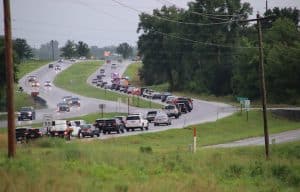Crash courses: studying problem areas, safe response
Below is a dual article series featured in the May 22nd edition of the Republic-Times, addressing county road safety issues for both drivers and emergency personel.
A Ford Expedition driven by Katherine Harper, 33, of St. Louis, was traveling northbound on Route 3 approaching Interstate 255 around 2 p.m. Sunday, when the vehicle veered off the roadway to the left, crossed the southbound lanes of Route 3, and continued down a hill before coming to rest on the Columbia Soccer Club fields. Harper was transported to St. Anthony’s Medical Center in St. Louis for treatment of minor injuries. (Corey Saathoff photo)
By ALAN DOOLEY
For the Republic-Times
There are locations in Monroe County that host vehicle crashes with greater frequency than others, with such incidents often associated with serious injuries or fatalities.
It is the responsibility of people like Monroe County Highway Engineer Aaron Metzger to try and determine what, or who, is to blame.
“We look for patterns, for trends, and examine each accident report to identify critical data,” Metzger said. “We look for recurring, similar events. Such patterns may suggest road changes as solutions.
Locations along Route 3, Kaskaskia Road, Ames Road, Bluff Road and other county thoroughfares have earned a reputation for hosting more than their fair share of serious crashes.
Metzger’s area of responsibility is limited to county highways. Federal, state and road district roads are handled separately.
In addition to scrutinizing accident reports, Metzger hears from residents who share reports of vehicles going off roads near their properties, or other incidents in which police aren’t contacted.
“People may get back on the
road, or call friends or family to help extricate them,” he said.
Metzger cited an example of a familiar state route that was improved. The “S” curve, located about five miles south of Waterloo on Route 3, was the site of a number of serious crashes caused by drivers crossing the center line, he said.
“Installing center line rumble strips has helped reduce incidents there,” he said. “The rumble strips get your attention instantly.”
The state solicits ideas for road projects each year, Metzger said. They analyze the proposals for those that offer serious challenges, have possible solutions, and are financially feasible. The projects they choose receive a share of federal highway safety funds.
“The Kaskaskia curves just beyond G Road are a current ongoing approved project,” Metzger said. “The road carries heavy traffic, may have poor night visibility, has winding curves and slippery surfaces when wet. Work there should start in August. Federal funds will pay for 80 percent and local funds will cover the remainder.” The county has so far installed flashing lights to alert motorists of the upcoming curves, and more signage, raised reflectors, raised banks on each curve, raised outer edges that make it harder to slide off the road, and asphalt shoulders to be added this summer, Metzger said.
But for the roads that cannot be easily changed — like Ames Road, on which crashes occur along its entire length — the fix is harder to come by.
“The state looks at benefit costs to decide which routes will be funded for improvement. While a relatively short stretch of Kaskaskia Road will be improved, virtually the entire length of Ames Road, which traverses hills and curves, would have to be redone. At this time, Monroe County does not have the necessary funds to acquire rights of way, straighten all the curves and flatten the hills on the lengthy road,” Metzger said.
Not all accidents involve curves or bad roads. Just south of the Route 3 “S” curve is a mile-long stretch of flat, straight highway that crosses Crook Road. Twice in the last year, drivers have left the road southbound and totaled their cars against the same cedar tree. Police cited excessive speed and inattention in both cases. On another segment of the same highway just a few hundred yards south, a fatal cross-over crash killed a family of three headed home one night last summer.
Monroe County Sheriff Dan Kelley said he commends efforts to make roads safer.
“But more often it’s operator error – inattentive driving or excessive speed — that causes most accidents. Failing to wear seat belts also contributes to fatalities,” he added. “All too often we arrive at a fatal accident scene and find the interior cage of the car intact. But people inside are either hurled around or thrown part way or all the way out of the car.”
Inattention, or “distracted driving,” most often stems from people trying to multi-task while driving.
“That may be talking on cell phones, texting, adjusting a radio, or taking to someone in the back seat,” Kelley said. “Human beings kid themselves if they think they can do two things at once — especially something as demanding as driving at highway speeds.”
Kelley also addressed young drivers, saying “they need to stay focused and minimize risk-taking.”
Many crashes involving new drivers occur when a wheel hits a shoulder and the inexperienced driver panics, jerks the steering wheel and crosses to the other side of a road, either hitting an oncoming car or going into a ditch, he said.
Kelley also cautioned against blaming all accidents on roads or conditions.
“Accidents occur on curves on Ames Road near South Fork Road in the spring, summer and fall, when conditions are good. In the winter when we have snow and ice, people slow down, and we have far fewer accidents,” Kelley said.
Monroe County safety and law enforcement personnel will continue to analyze accident patterns.
“Where we can see problems, and identify sound fixes to help save lives, and where economic factors can be answered, we will continue to press ahead,” Metzger said.
He agreed with Kelley’s assertion that while engineers can measure and assess velocities, bank heights, coefficients of friction and visibility factors, they cannot compensate for driver errors.
Part 2:
By ANDREA DEGENHART
For the Republic-Times
A training class aimed at teaching emergency first responders strategies to keep themselves safe at crash scenes drew attendees from across the metro-east to Columbia earlier this month.
“We had some close calls on the highways of firefighters having near misses with vehicles at traffic accidents,” said Columbia Fire Department Assistant Chief Don Sutter.
Called “secondary crashes,” these incidents can be devastating to personnel working on an emergency scene.
“A lot of times, secondary crashes can be worse than the original incident,” Columbia Deputy Police Chief Jerry Paul said.
In the class, which was given by the Illinois Department of Transportation, police, firefighters, ambulance personnel and tow truck drivers learned how to set up a crash scene to maximize awareness of lane and shoulder closures and minimize responders’ exposure to dangerous situations.
“It’s about everyone (on a crash scene) working together to get done faster and get off the scene to safety,” Paul said.
Among the strategies they learned were how to place traffic control devices like flares and cones for the greatest impact in alerting drivers to a crash scene and where to park emergency vehicles to provide protection to personnel on the scene.
“You can’t replace a life,” Sutter said. “We’d rather have someone take out an emergency vehicle.”
One of the greatest factors in crash scene safety is understanding how long it takes a car traveling on a highway to come to a stop, due in part to drivers’ reaction times getting slower as a result of distracted driving.
“One of the scariest things is that cars are more soundproof and more comfortable,” Sutter said. “It feels like drivers are in their living rooms.”
The effect of these upgrades to vehicle cabins is that it is harder to hear emergency sirens, and drivers are more likely to be engaged in activities other than driving.
And it’s not only young drivers who are putting emergency responders at risk. Sutter has noticed it is often experienced drivers who are less aware of how long it takes to come to a stop – up to 200 yards, or two football fields, for a car driving the speed limit on the interstate.
“We’re all conscious of trying to get the roadway open,” Sutter said. “We were encouraged to try to keep at least one lane open at all times.”
When there are lane reductions, or even a roadway closure, Sutter wants drivers to exercise patience, and to know that emergency responders are aware of the inconvenience it can cause and are working to get the scenes cleared as quickly as possible.
“We’re gong to do our best efforts to keep everything open,” Sutter said. “But whatever we have to do, it’s for the safety of us and the victims.”






